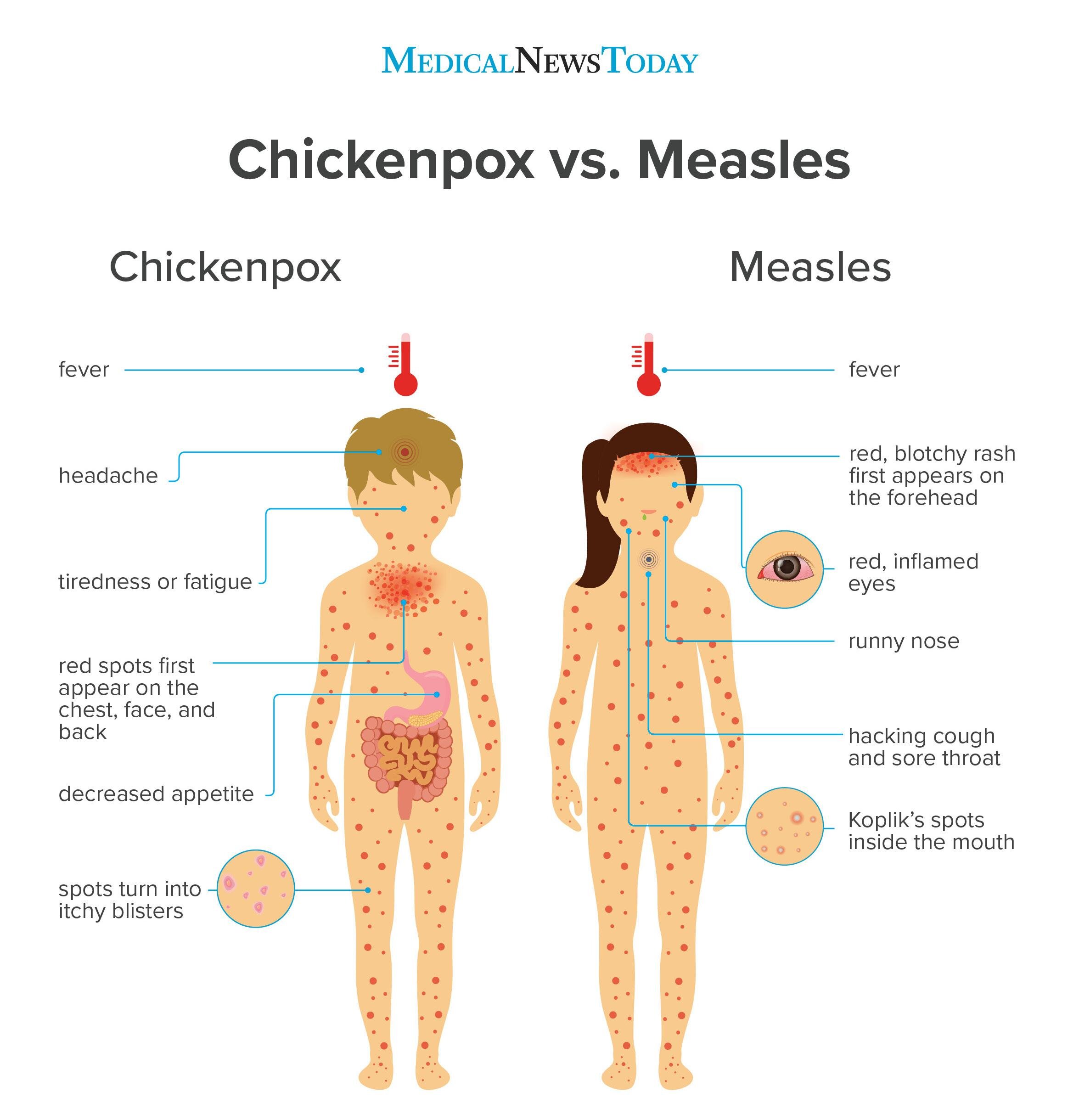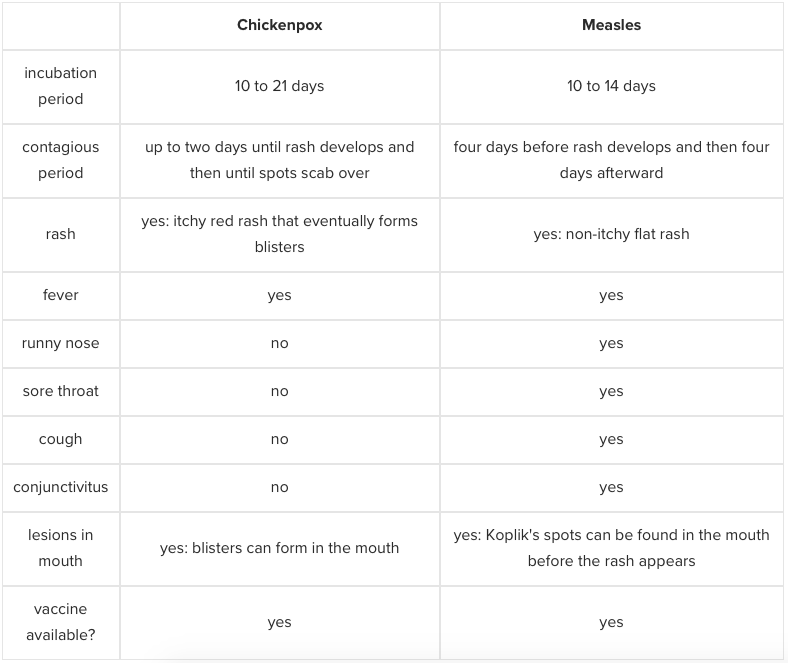Chickenpox vs. measles: What's the difference?
Overview
Chickenpox and measles are both infectious diseases that are caused by viruses. They're caused by two different viruses. Chickenpox is caused by the varicella-zoster virus. Measles, also called rubeola, is caused by the measles virus.
Both diseases used to be common childhood infections, but now are preventable through vaccination. There are still far fewer cases of measles in the US each year than chickenpox.
Let's take a deeper look at chickenpox and measles and see what makes them different.
Chickenpox vs. measles symptoms
The symptoms of chickenpox include:
a rash that initially shows up on your chest, face, and back, but can spread to the rest of your body
tiredness or fatigue
decreased appetite
The common symptoms of measles include:
a rash that first shows up at your hairline or forehead, and then spreads downward to other parts of your body
fever
hacking cough
runny nose
red, inflamed eyes (conjunctivitis)
Koplik's spots (small red spots with blue-white centers found inside your mouth and cheeks)
While both diseases cause a telltale rash to develop, the appearance of the rash differs between the two viruses. This can be a simple way to distinguish between the two diseases.
The chickenpox rash starts with raised red bumps or papules. These bumps turn into itchy fluid-filled blisters, or vesicles, that will eventually rupture and leak before scabbing over.
The measles rash appears as flat red spots, although raised bumps may sometimes be present. If bumps appear, they do not have fluid in them. The spots of the measles rash may begin to run together as the rash spreads.
Credit: Medical News Today
Chickenpox vs. measles contagious period
Both chickenpox and measles are highly contagious, meaning that you can easily spread them to others.
Chickenpox is spread through inhaling respiratory droplets that are generated when a sick person coughs or sneezes. It can also be spread through contact with contaminated surfaces or with fluid from the ruptured blisters.
You're contagious with chickenpox up to two days before the rash appears. You'll remain contagious until all of your spots have crusted over.
Like chickenpox, measles can be spread through the air when a sick person coughs or sneezes as well as through contact with a surface or object that has been contaminated.
Measles is contagious up to four days before the rash appears and then for four days afterward.
Chickenpox vs. measles treatment
Since both chickenpox and measles are caused by a viral infection, treatment is focused on easing symptoms until the infection clears.
Since the chickenpox rash can be very itchy, your doctor may prescribe an antihistamine to help with itching.
Some people are at high risk for complications from chickenpox infection, including:
people with a weakened immune system
people taking steroid medication
unvaccinated babies
adults who've never had or been vaccinated against chickenpox
These groups may be prescribed an antiviral medication, such as acyclovir, which can help to decrease the severity of the infection.
If you think you've been exposed to measles (or chicken pox if you've not had the disease) and you aren't vaccinated, you may be given the vaccine and possibly a protein called immune globulin as a post-exposure therapy. If you do come down with measles or chicken pox, the disease may be milder.
Chickenpox vs. measles home management
You can help ease the symptoms of both infections by doing the following:
Rest up and drink plenty of fluids.
Use an over-the-counter (OTC) medication, such as acetaminophen or ibuprofen, to relieve fever. NOTE: Never give aspirin to children.
If you have a cough or sore throat, use a humidifier help ease discomfort.
Follow the tips below for dealing with the chickenpox rash:
Don't scratch chickenpox spots — no matter how much they itch! This can lead to scarring or infection. If your child has chickenpox, consider putting gloves on their hands or clipping their fingernails to deter scratching.
Take a cool bath or use cool compresses to ease itching. An oatmeal bath may also be beneficial. Use a clean towel to gently pat yourself dry afterward.
Dab calamine lotion on any itchy spots, avoiding the eyes and face.
Use an OTC antihistamine, such as Benadryl, to help relieve itching. Your doctor may also prescribe an antihistamine.
If blisters form in your mouth, try to eat cold, bland foods while avoiding hot, spicy, or acidic foods.
Chickenpox vs. measles vaccines
Chickenpox and measles can be prevented through vaccination.
These vaccines are both part of a child's normal vaccination schedule. Both vaccines are given in two doses. The first dose is given between 12 and 15 months of age, while the second dose is given between the ages of 4 and 6 years.
If you weren't vaccinated for either disease as a child, you should plan to get vaccinated. This not only protects you from infection, but also helps to prevent chickenpox and measles from circulating within your community.
Chickenpox vs. measles outlook
A chickenpox infection typically lasts between 5 and 10 days. Chickenpox is typically mild, but can cause severe complications in at-risk groups.
Once you've had chickenpox, it's very unlikely that you'll get it again. However, the virus remains dormant within your body and can reactivate as shingles later in life.
A measles infection can last over a timeframe of two to three weeks. The possible complications of measles infection include ear infections, bronchitis, pneumonia, and encephalitis.
Once you've had measles, you can't get it again.


